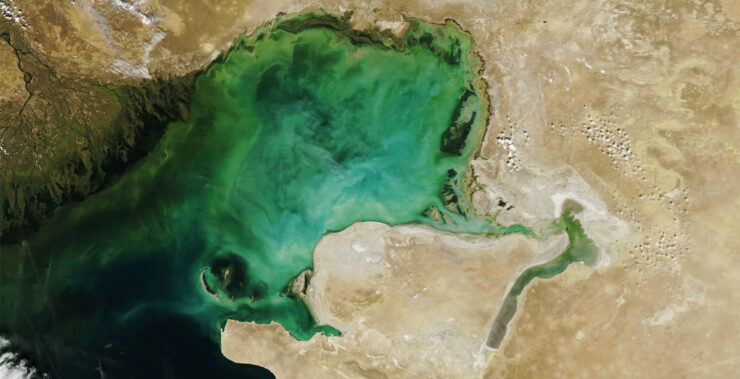Climate change and reduced water inflow from Volga River have caused the Caspian Sea level to drop by more than two meters since the mid-1990s. This article presents key points raised in the recent articles by Clément Girardot in the Ecologist and Geographical, an analysis by Aida Amangeldina in Beda.media, and the article by Prange, Wilke, and Wesselingh in the journal Nature.
The Caspian Sea has been experiencing a rapid decline in water levels since the mid-1990s. Projections show the sea level may decrease by 9-18 meters by the end of the century, causing 23-34% of the sea’s surface area to disappear. In the northern regions the shoreline has already retreated by almost 50 kilometers.
The decline is primarily driven by climate change-induced evaporation. However, reduced inflows from major rivers like the Volga also contribute to the decline. In recent decades Russia has built large reservoirs and increased the water intake for its own agricultural and energy needs, as well as drinking water.
Additionally, industrial activities in the Caspian Sea, particularly oil and gas extraction, contribute to pollution and accelerate the environmental degradation. This crisis threatens biodiversity, regional economies, and geopolitical stability.
The effects of the sea shrinkage
Donate to support Turkmen analysts, researchers and writers to produce factual, constructive and progressive content in their efforts to educate the public of Turkmenistan.
SUPPORT OUR WORKThe consequences of the Caspian Sea’s level decline are severe:
- Biodiversity loss and threats to many endangered species, including the Caspian seal, decline in fish populations, and large-scale die-offs.
- Economic impacts: fishing, transportation, and tourism industries are severely impacted, causing problems for many coastal communities.
- Social impacts: coastal communities may have to be displaced due to loss of livelihoods.
- Health and environmental impacts: receding waters expose vast barren areas that contribute to more severe and frequent sandstorms that pose health risks and threaten livestock and agriculture.
- Geopolitical impacts: the five bordering nations – Kazakhstan, Azerbaijan, Russia, Iran, and Turkmenistan – face increased tensions over resource management, environmental management, and water management in the region that is already struggling with water scarcity.
Experts and researchers emphasize the need for urgent action:
- Implementing sustainable water policies, in particular regarding the regulation of river inflows. Impacts of water desalination, which is currently actively explored by many including Turkmenistan, on sea level should also be considered.
- Strict monitoring and regulation of oil extraction activities to reduce hydrocarbon contamination.
- Countries in the Caspian basin need to cooperate on a collective strategy to address the crisis. Azerbaijan has proposed such an initiative at COP29 but concrete actions are yet to be taken.
- Establishing a dedicated research institution and involving international experts are important to manage the efforts to limit the sea level decline.
The shrinkage of the Caspian Sea is a growing environmental disaster, reminding many of the Aral Sea disaster. Unlike global sea level rise, inland water level decline is not widely discussed, yet it demands urgent regional and global action. Without immediate measures, millions of livelihoods and a unique ecosystem remain at risk.






